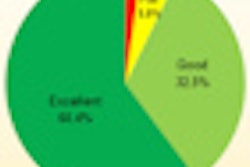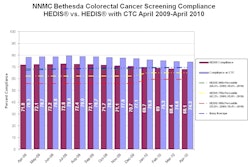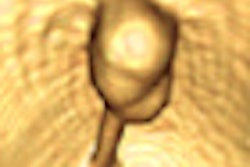In a meta-analysis of more than 10,000 patients scanned on five continents, virtual colonoscopy detected almost 95% of colorectal cancers -- and 100% when proper tagging and cleansing methods were used, according to a study published in the May edition of Radiology.
The study suggests that VC is ready for universal use, the authors concluded.
Few assessments can be found in the literature of the cancer detection rate of virtual colonoscopy (also known as CT colonography or CTC), noted lead author Dr. Perry Pickhardt, from the University of Wisconsin, and colleagues from three other institutions in the U.S. and Europe.
Cancer sensitivity is difficult to assess primarily because the prevalence of frank cancers is extremely low, especially in the screening setting, making the total number of cancers in any single study too low to evaluate, they explained. Moreover, most CTC studies take aim at prevention by focusing on CTC's detection rate of advanced adenomas, or colorectal polyps of any type 1 cm and larger.
But if annual fecal occult blood testing (FOBT), with its low sensitivity, can reduce mortality for colorectal cancer, tests such as colonoscopy and CTC that aim to visualize cancers directly ought to be able to do it better, Pickhardt and colleagues wrote (Radiology, May 2011, Vol. 259:2, pp. 393-405).
The data were compiled by means of a literature search for colonography studies beginning in 1994, in which an independent histologic reference standard was used to differentiate benign from malignant colorectal polyps.
The authors, from the University of Wisconsin, the National Institutes of Health, the University of Rome, and University College London, excluded studies that lacked such details or sufficient information regarding polyp detection. Also excluded were studies with a high prevalence of cancer owing to high-risk populations, and studies with fewer than 30 patients, they wrote.
The group relied on predefined data extraction forms to evaluate the study populations, including the bowel preparation details, CT scanner settings, and confirmation methodology, and noted whether the study included segmental unblinding of virtual colonoscopy results to eliminate the problem of true-positive CTC findings that were missed at subsequent optical colonoscopy.
In analyzing the data, the authors paid particular attention to whether the cohorts were asymptomatic or included some subjects at higher risk for colorectal cancer. They looked at the time interval between the index and reference tests, whether the colonoscopy reference standard could be modified by the CTC results (segmental unblinding), and lesion measurement techniques.
The primary end points of the review were the per-patient sensitivity of CTC for cancer and the per-patient sensitivity of optical colonoscopy for cancer. The authors were contacted to supply missing study details when needed.
In all, the researchers analyzed 49 studies including data on 11,151 patients, who had a cumulative colorectal cancer prevalence of 3.6% -- a total of 414 cancers.
Results
Only six studies (with 4,883 patients or 42.3% of the total) included only asymptomatic screening subjects. The remaining 43 studies (6,668 patients or 57.7% of the total) examined a symptomatic and/or disease-enriched population.
The results showed impressively high sensitivity for CTC versus colonoscopy, they reported.
When only the 25 studies in which simultaneous evaluation with CTC and colonoscopy were available for analysis, data from 9,223 patients (79.8% of the total) could be analyzed. Those studies showed the sensitivity of CTC for colorectal cancer to be 94.7% (178 of 188; 95% confidence interval: 90.4%-97.2%).
Of importance, sensitivity was high and no cancers were missed at CTC when both cathartic and tagging agents were combined in the bowel preparation, Pickhardt and colleagues wrote.
"When one considers the large number of cancer cases included, the wide range in CT colonography techniques used, and the lack of heterogeneity in the CT colonography sensitivity estimate, our study results support the clinical equivalence between CT colonography and optical colonoscopy for the detection of invasive cancer," the authors wrote.
Sensitivity varied little even though the exam methods were quite different, according to the authors.
"In particular, it is important to note that the use of either a primary 2D mode or a primary 3D mode for lesion detection, which is a critical distinction for polyp sensitivity, had little impact on cancer detection, as most invasive cancers are readily detectable on 2D views," the authors wrote.
The group cited several limitations to the study. Because an enhanced reference standard (segmental unblinding) was used in only 25 of the studies, the rest of the papers might have underestimated CTC's sensitivity by counting true-positive CTC detections as false positives when they were not also found on conventional colonoscopy through segmental unblinding.
In addition, none of the studies used TNM (tumor, node, metastasis) staging or Duke classifications to stage the cancers, so it wasn't possible to gauge VC's sensitivity to early-stage cancers. Nevertheless, a recent study of more than 5,000 patients showed that the vast majority of colorectal cancers are 3 cm and larger, making it unlikely for CTC to have missed many early-stage cancers.
"Given the relatively low prevalence of colorectal cancer, even among symptomatic cohorts, our findings suggest that, assuming a reasonable level of specificity, primary CT colonography may be more suitable than optical colonoscopy for the initial investigation of suspected colorectal cancer," the group concluded.



















